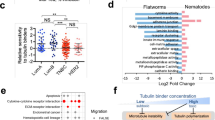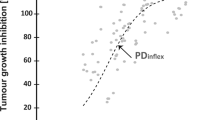Abstract
In solid tumors, the reasons for the lack of in vitro andin vivo correlation of drugactivities are multifold and includespermeability to the tumor cells,interstitial hypertension and metabolicdegradation. So, it is important to studythe permeability and metabolic dispositionof new compounds early in discovery anddevelopment of anticancer drugs. Anexperimental anti-cancer drug, SH 30demonstrated highly selective and potentcytotoxic activity against a number ofmulti-drug resistant tumor cell lines in vitro. However, it was inactive in amurine tumor model. This study wasconducted to identify the barriers thatresult in lack of correlation between in vitro and in vivo cytotoxicactivity of novel anticancer agents. Twoimportant barriers: physical(permeability) and metabolic (enzymaticinactivation) to poor delivery of SH 30 tosolid tumors were investigated in thisstudy. Tumors were sliced to separate thevascular and avascular sections. Theconcentrations of the drug at variousregions of the tumor after single andmultiple doses were investigated todetermine the permeability barrier. Thepermeability barrier was also probed usingtwo in vitro model systems, namely,matrigel® films representing extracellularmatrix and caco-2 multilayer cell culturesthat simulate solid tumors. The drug andits metabolite concentrations weredetermined in the plasma and tumors todetermine the metabolic barrier to the drugcytotoxic action. The metabolic barrierwas further probed using in vitromouse hepatocytes and liver microsomepreparations. Our examination revealed themetabolic barrier to be the majorcontributor to the ineffectiveness of SH 30in vivo. Examination ofconcentration of the drug across variousregions of the tumor corroborated by datafrom in vitro permeation studiessuggested that, for SH 30, permeabilitybarrier did not exist. After singleinjection, the concentrations of SH 30 andits metabolites in plasma and tumor werecomparable to another investigational drugwith similar features (XK 469). Contraryto day 1, after 8 consecutive days ofadministration, SH 30 concentrations weresignificantly lower, while the metabolitesconcentrations were higher, suggestingextensive metabolism due to induction ofenzyme(s). The in vitro hepatocytesand liver microsome results also showed SH30 biotransformation to the samemetabolites. Neither drug penetration, nordrug distribution into regions of thetumors distal to vasculature were impeded. The inactivity of SH 30 in vivo isprimarily due to induction of extensivemetabolism to inactive metabolites. Thismetabolism prevents adequate drug levelsbeing achieved in the tumor.
Similar content being viewed by others
References
Gumbleton T, Sneader W: Pharmacokinetic Considerations in Rational Drug Design. Clin Pharmacokinet 26(3): 161–168, 1994
Humphrey M, Smith D: Role of metabolism and pharmacokinetic studies in the discovery of new drugs – present and future perspectives. Xenobiotica 22: 743–755, 1994
Lin JH, Lu AYH: Role of pharmacokinetics and metabolism in drug discovery and development. Pharmacological Reviews 49(4): 403–448, 1997
LoRusso PM, Parchment RE, Demchik L, Knight J, Polin L, Dzubow J, Behrens C, Harrison B, Trainor G, Corbett TH: Preclinical antitumor activity of XK469 (NSC 656889). Invest New Drugs 16: 287–296, 1999
Corbett TH, LoRusso PM, Demchick L, Simpson C, Pugh S, White K, Kushner J, Polin J, Meyer J, Czarnecki J, Heilbrun L, Horwitz JP, Gross JL, Behrens CH, Harrison BA, McRipley RJ, Trainor G: Preclinical antitumor efficacy of analogs of XK469: sodium-(2-[4-(7-chloro-2-quinoxalinyloxy)phenoxy]propionate. Invest New Drugs 16: 129–139, 1998
Gao Huang HKC, Yamasaki HF, Chan KK, Chohan L, Snapka RM: XK 469, a selective topoisomerase IIβ poison. Proc Nat Ac Sci 96(21): 12168–12173, 1999
Valeriote F, Moore RE, Patterson GML, Paul VJ, Scheuer PJ, Corbett TH: Discovery of Natural Products from Microalgae and Marine Organisms. In F.H. Valeriote, T.H. Corbett and L.H. Baker (Eds.), Anticancer Drug Discovery and Development, Kluwer Academic Publishers, Boston, pp 5–6, 1994
Goldacre R, Sylven B: On the access of blood borne dyes to various tumor regions. Br J Cancer 16: 1–5, 1962
Kerr D, Kaye S: Aspects of cytotoxic drug penetration with particular reference to anthracyclines. Cancer Chemother Pharmacol 23: 291–307, 1985
Durand R: Distribution and activity of antineoplastic drugs in a tumor model. J Natl Cancer Inst 81: 146–152, 1989
Phillips R, Loadman P, Cronin B: Evaluation of a novel in vitro assay for assessing drug penetration into avascular regions of tumors. Br J Cancer 77(12): 2112–2119, 1998
Kleinman HK, McGarvey ML, Liotta LA, Robey PG, Tryggvason K, Martin GR: Isolation and characterization of type IV procollagen, laminin, and heparan sulfate proteoglycan from the EHS sarcoma. Biochemistry 21: 6188–6193, 1982
McGuire PGaS, N.W. Journal of Cell Biochemistry 0: 215, 1989
Minchinton AI, Wendt KR, Clow KA, Fryer KH: Multilayers of cells growing on a permeable support. An in vitro tumour model. Acta Oncol 36: 13–16, 1997
Gres MC, Julian B, Bourrie M: Correlation between oral drug absorption in humans, and apparent drug permeability in TC-7 cells, a human epithelial intestinal cell line: comparison with the parental Caco-2 cell line. Pharm Res 15: 726–733, 1998
Tunggal JK, Cowan DSM, Shaikh H, Tannock IF: Penetration of anticancer drugs through solid tissue: A factor that limits the effectiveness of chemotherapy for solid tumors. Clin Cancer Res 5: 1583–1586, 1999
Author information
Authors and Affiliations
Rights and permissions
About this article
Cite this article
Poondru, S., Parchment, R.E., Purohit, V. et al. Lack of in Vitro – in Vivo Correlation of a Novel Investigational Anticancer Agent, SH 30. Invest New Drugs 20, 23–33 (2002). https://doi.org/10.1023/A:1014457510073
Issue Date:
DOI: https://doi.org/10.1023/A:1014457510073




